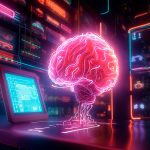Table of Contents
1. Introduction to Generative AI
1.1 Definition of Generative AI
Generative AI refers to a type of Artificial Intelligence that can create new content, whether it’s text, images, music, or even entire digital experiences. Unlike traditional AI, which typically analyzes and processes existing data, generative AI goes a step further by generating new data based on learned patterns.
1.2 Brief History and Evolution
The roots of generative AI can be traced back to early machine learning developments in the mid-20th century. However, it wasn’t until the advent of powerful neural networks in the 2010s that generative models like Generative Adversarial Networks (GANs) gained prominence. Since then, the field has grown rapidly, leading to astonishing advancements in creativity and automation.
1.3 Importance of Generative AI in Today’s Technology Landscape
In today’s digital-first world, generative AI is transforming industries by enabling individuals and businesses to push the boundaries of creativity and efficiency. It serves as a powerful tool, allowing creators to think outside the box and companies to optimize processes seamlessly.
2. Generative AI in Creative Industries
2.1 Art and Design
2.1.1 AI-Assisted Artwork Creation
Many artists are now collaborating with AI to create stunning pieces of art. Tools like DeepArt and DALL-E allow users to generate artwork based on simple prompts or coffee shop conversations, merging human creativity with machine learning.
2.1.2 The Role of AI in Graphic Design
AI tools have started reshaping graphic design by automating repetitive tasks such as image resizing and providing layout suggestions based on design principles. Programs like Canva utilize AI to enhance user experience by streamlining design processes.
2.1.3 Collaborative Projects Between Humans and AI
There are exciting projects where artists work alongside AI systems to create unique pieces. For instance, the partnership between human musicians and AI-generated music shows how collaboration can lead to unexpected artistry.
2.2 Music and Sound
2.2.1 Composition and Songwriting with AI
AI tools like Amper Music and Aiva can compose music across various genres. They allow users, even those without musical background, to create original tracks by simply choosing the mood and style they want.
2.2.2 Generating Unique Soundscapes
Generative AI can craft ambient sounds for various settings, such as video games or meditation apps. These systems synthesize sounds that adapt based on user preferences, creating dynamic audio environments.
2.2.3 Applications in Film Scoring
Film studios are starting to leverage AI to assist in scoring films. Using learned patterns from past soundtracks, these AI systems can produce soundtracks tailored to specific scenes, speeding up the creative process.
2.3 Literature and Content Creation
2.3.1 AI-Generated Stories and Poetry
AI writing tools like GPT-3 can now generate coherent and engaging narratives. Whether someone wants a short story or even poetry, these systems provide writers with new inspiration and possibilities.
2.3.2 Assisting Authors in Writing
Authors can use AI as a brainstorming partner, helping them develop plot ideas or even character dialogues. Tools like Sudowrite encourage creativity by suggesting alternative story paths.
2.3.3 AI in Journalism and News Generation
Many news outlets are adopting AI to draft articles or summarize stories. While human journalists focus on investigative reporting, AI handles data-heavy stories efficiently, allowing newsrooms to serve audiences better.

3. Business Applications of Generative AI
3.1 Marketing and Advertising
3.1.1 Personalized Ad Campaigns
Generative AI enables brands to create personalized advertisements for niche audiences. By analyzing user behavior, advertisers can design targeted campaigns that resonate deeply with potential customers.
3.1.2 Content Creation for Digital Marketing
Marketers are using AI to generate blog posts, social media updates, and email newsletters. This not only saves time but allows for consistent messaging across various platforms.
3.1.3 AI in Market Research and Consumer Insights
Businesses can analyze massive datasets to identify patterns and consumer trends. This deep dive helps companies make informed decisions about their marketing strategies and product offerings.
3.2 Product Design and Development
3.2.1 Rapid Prototyping and AI-Driven Innovation
Generative AI is streamlining the prototyping phase of product design. By simulating numerous designs quickly, companies can experiment with various concepts before committing to a final product.
3.2.2 Customization of Products through AI
With the help of AI, businesses can offer customized products tailored to individual preferences. From shoes to cars, customers can get stylized goods designed just for them, enhancing satisfaction.
3.2.3 Improving User Experience with Generative Models
Using AI-driven generative models, businesses are refining user interfaces and experiences, ensuring that customer interactions are as intuitive and enjoyable as possible.
3.3 Data Analysis and Forecasting
3.3.1 Predictive Analytics in Business Strategy
Generative AI enhances predictive analytics by offering insights that help businesses forecast market trends and make data-driven decisions for future initiatives.
3.3.2 AI for Financial Modelling
Financial experts are turning to AI to build complex financial models. AI can simulate various economic conditions, allowing companies to strategize better and mitigate risks.
3.3.3 Automating Data Reporting and Visualization
Many firms are adopting AI tools to automate reporting processes and create visually appealing data presentations. This enables stakeholders to make quicker, informed choices.
4. Generative AI in Healthcare
4.1 Medical Imaging and Diagnosis
4.1.1 Enhancing Imaging Techniques with AI
AI tools are refining medical imaging by providing high-resolution images, minimizing noise and artifacts, and allowing radiologists to interpret data efficiently.
4.1.2 AI in Disease Prediction and Early Detection
Generative AI is making strides in predicting diseases before symptoms arise. Algorithms trained on extensive databases can identify patterns and anomalies that suggest an early need for intervention.
4.1.3 Case Studies of AI in Imaging Practices
Real-life examples show hospitals implementing AI-driven imaging systems leading to quicker diagnoses and improved patient outcomes, thus enhancing overall healthcare quality.
4.2 Drug Discovery and Development
4.2.1 AI Models in Identifying Potential Pharmaceuticals
AI assists scientists in identifying new drug candidates by analyzing biological data and predicting how different compounds can interact with diseases.
4.2.2 Streamlining the Drug Development Process
By simulating drug interactions and side effects, generative AI significantly shortens the time traditionally needed for drug development, potentially saving lives and resources.
4.2.3 Success Stories in the Pharmaceutical Industry
Notable examples exist where companies leveraged AI in drug development, resulting in faster market access for groundbreaking treatments.
4.3 Patient Care and Management
4.3.1 Personalized Treatment Plans through AI
AI helps create personalized treatment plans, taking into account individual patient history and genetic information, leading to more effective care.
4.3.2 AI Chatbots in Patient Interaction
Many healthcare providers are incorporating AI-driven chatbots to manage patient interactions, providing immediate responses to queries while freeing up human resources.
4.3.3 Ethical Considerations in AI-Assisted Care
As the use of AI grows in healthcare, it’s critical to address ethical concerns, including data privacy, consent, and the role of human oversight in medical decisions.
5. Generative AI in Education
5.1 Personalized Learning Experiences
5.1.1 AI for Tailoring Educational Content
Generative AI can analyze a student’s learning style and adapt educational content to make lessons more effective and engaging.
5.1.2 Adaptive Learning Systems and Their Benefits
These systems adjust the difficulty of tasks based on student performance, ensuring that each individual progresses at their own pace.
5.1.3 Case Studies of Schools Implementing AI Solutions
Schools across the globe are successfully implementing AI technologies to enhance learning environments, showcasing the positive impact on student engagement and achievement.
5.2 Content Creation and Curriculum Development
5.2.1 Using AI to Generate Teaching Materials
Educators are turning to AI to help create custom worksheets, quizzes, and interactive lessons, significantly reducing planning time.
5.2.2 Collaborative Curriculum Design with AI Tools
Teachers can collaborate with AI to design curricula that address learning gaps and meet diverse student needs.
5.2.3 Challenges in AI-Driven Education Materials
There are challenges with relying on AI for educational content, such as ensuring accuracy, diversity of perspectives, and pedagogical soundness.
5.3 Assessments and Feedback
5.3.1 AI in Automated Grading Systems
AI-driven grading systems can assess assignments and provide instant feedback, allowing teachers more time to focus on instruction.
5.3.2 Real-Time Feedback for Students
Students benefit from immediate feedback on assessments, enabling them to understand errors and improve their skills more efficiently.
5.3.3 Limitations and Concerns in AI Assessment
While convenient, AI assessments raise questions about fairness and bias, making it essential to monitor their implementation closely.
Conclusion
– Summary of Key Insights
Generative AI is revolutionizing various industries through creative collaboration, enhanced efficiency, and improved services. From art to healthcare, the impact of AI is profound.
– Future Trends and Predictions in Generative AI
Looking ahead, we can expect generative AI to evolve with even more sophisticated models and applications, fostering creativity and innovation across sectors.
– Final Thoughts on Ethical Considerations and Responsibilities
While the benefits are substantial, it’s vital that we address ethical concerns surrounding privacy, bias, and human oversight, ensuring generative AI serves humanity positively.
FAQs
Q. What is generative AI?
A. Generative AI refers to a form of artificial intelligence that can produce new content based on learned data patterns.
Q. How is generative AI different from traditional AI?
A. While traditional AI analyzes and processes data, generative AI creates new data or content from scratch.
Q. What are some common tools and platforms used in generative AI?
A. Some popular tools include DALL-E for images, GPT-3 for text, and Amper Music for music generation.
Q. What industries are most impacted by generative AI?
A. Creative industries, healthcare, education, and business are among the sectors experiencing significant transformations due to generative AI.
Q. Are there ethical concerns associated with the use of generative AI?
A. Yes, ethical concerns include data privacy, potential bias in AI models, and the need for human oversight in decision-making.
Q. How can businesses start integrating generative AI into their workflows?
A. Businesses should begin by identifying areas where AI can enhance productivity, experimenting with various tools, and educating their teams on the technology.



